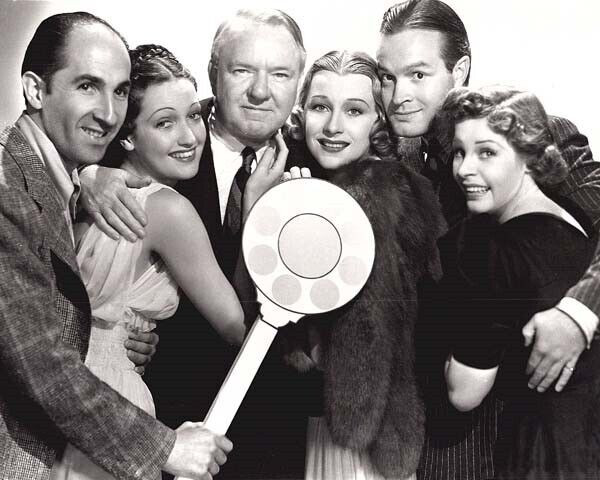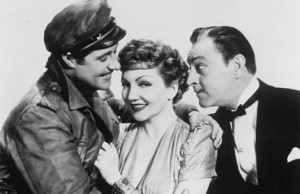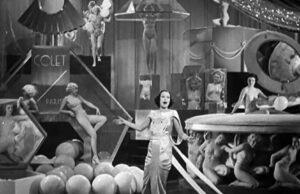The Big Broadcast of 1938 (1938)

Toronto Film Society presented The Big Broadcast of 1938 (1938) on Monday, July 21, 1986 in a double bill with Easy Living as part of the Season 39 Summer Series, Programme 3.
Production Company: Paramount. Producer: Harlan Thompson. Director: Mitchell Leisen. Screenplay: Walter deLeon, Francis Martin, Ken Englund, based on an adaptation by Howard Lindsay and Russel Crouse of an unpublished story by Frederick Hazlitt Brennan. Editor: Eda Warren, Chandler House. Photography: Harry Fishbeck. Art Direction: Hans Dreier, Ernst Fegte. Costume Design: Edith Head. Music: Boris Morros. Songs: Ralph Rainger, Leo Robin, Richard Wagner. Dances: Le Roy Prinz. Release Date: February 11, 1938. Shooting: September 13 to November 15, 1937.
Cast: W.C. Fields (T. Frothinghill Bellows/S.B. Bellows), Martha Raye (Martha Bellows), Dorothy Lamour (Dorothy Wyndham), Shirley Ross (Cleo Fielding), Lynne Overman (Scoop McPhail), Bob Hope (Buzz Fielding), Ben Blue (Mike), Leif Erikson (Bob Hayes), Grace Bradley (Grace Fielding), Rufe Davis (Turnkey), Lionel Pape (Lord Droopy), Russell Hicks (Captain Stafford), and Tito Guizar, Shep Fields and his Rippling Rhythm Orchestra, Kirsten Flagstad of the Metropolitan Opera Company with Wilfred Pelletier, Conductor, etc.

During the 1930s the revue-style musical film flourished in Hollywood, particularly at Paramount. Films such as The Big Broadcast (1932), The Big Broadcast of 1936 (1935), The Big Broadcast of 1937 (1936-also directed by Leisen), The Big Broadcast of 1938, College Holiday (1936), College Humor (1933), College Rhythm (1934), College Swing (1938), Artists and Models (1937) and Artists and Models Abroad (1938) are of lasting value in film history chiefly as showcases for some of the greatest talent in show business of that era. Entertainers ranging from Bing Crosby, George Burns and Gracie Allen, Jack, Benny, Kate Smith, Bob Hope, Martha Raye, Ben Blue, Lyda Roberti, Cab Calloway, Judy Canova, the Boswell Sisters, Shirley Ross, Benny Goodman, Leopold Stokowski, Kirsten Flagstad, Louis Armstrong, Shep Fields, Joe Penner, Lanny Ross, the Mills Brothers, Ethel Merman, Richard Tauber, and the Nicholas Brothers made appearances in these films, some briefly, others many times. Practically all of the stars were at their prime, most just first tasting the fruits of superstardom when called by Paramount to appear. Certainly all of the films were musical hodge-podges, with classical works mixed up with pop and jazz classics and novelty numbers. The films were simply vaudeville shows as excuses to show high-profile talent to the masses in the pre-television era–they were really forerunners of the Ed Sullivan Show. All of the films blended ample comedy scenes and characters with the music–fortunately Burns and Allen appeared in six of these films (but unfortunately missed only tonight’s film among the Big Broadcast four) and Bob Hope in two.
None of the films pretended to be cinematic or musically important–they were just meant to be entertaining with the top musical and comedy talent of the day. Paramount seemed to specialize in this sub-genre much more so than any other studio and had consequently perfected a slick style in this genre that no other studio could match. The directors involved just considered the films “a job of work”, and rarely put much effort into them. Mitchell Leisen stated, after a screening of The Big Broadcast of 1938 just prior to his death, “It was my most embarrassing moment when they ran that one at the Greystone.” The films were always entertaining, yet they never evinced much directorial style or personality–you couldn’t really tell whether a Mitchell Leisen or a Frank Tuttle or a Norman Taurog or a Raoul Walsh directed one or another (they each directed at least two of the series). The films were generally cast with talented radio personalities who repeated on screen what they had perfected before the mike hundreds of times–they needed no film director and would actually permit nothing to change their style. Musical production numbers were aways geared for the performers and thus revealed little originality.
But against these negative points must again be emphasized the fact that these films gave mass audiences of the period glimpses of the star entertainers of the era at their zenith–and today we have no other visual record of Kirsten Flagstad singing than in The Big Broadcast of 1938. Flagstad (1895-1962) was a Norwegian soprano of no fame until she sang Wagner at Bayreuth in 1934 and at the Met the following year. After she had electrified the musical world with her incredible voice and tone by 1936, she was at the top of her profession. Critics rhapsodized that she had surpassed all the greatest Wagnerian sopranos of the Golden Ages, Olive Fremstad, Lillian Nordica, Frieda Leider; and she would not be equaled by Helen Traubel or Birgit Nilsson. Flagstad found an equally unique tenor to partner her at the Met, Lauritz Melchior (1980-1973); TFS showed one of his several Hollywood musicals, The Stars Are Singing, several years ago in one of our Film Buff series), and together they led a revitalized Wagner segment of the Met to unparalled glories–many have written that Flagstad essentially saved the Met during the depression–her appearances were always sold out, with the duo of Flagstad/Melchior duplicating the legendary popularity of Caruso/Farrar twenty-five years earlier at the Met. Small wonder that Bob Hope introduces Flagstad’s segment in The Big Broadcast of 1938 as with “the world’s greatest living soprano”–she was. What a pity that all we have on film is this three minute excerpt from Die Walküre–what a priceless treasure a complete opera film of Flagstad/Melchior singing ‘Tristan und Isolde’ in 1938 would have been!
Mitchel Leisen was not a fan of W.C. Fields, and commented: “He was the most obstinate, ornery son of a bitch I ever tried to work with. Really. He used to say, ‘Waal, I think I’d better go down and rehearse my dialogue.’ We’d sit around waiting for him to come back, and he’d finally come back, two hours later, very well soused and say, ‘I’ve decided I’m not going to do that routine after all,’ just to louse you up. One time I said, ‘Bill, you did exactly the same routine in your last picture.’ He said, ‘I did not. This one is different.’ I said, ‘What’s different in it?’ He said, ‘In the other one it’s a bottle of whiskey, in this one it’s a bottle of gin.’ I think he charged the studio $25,000 every time he did one of his routines. That pool routine was in every picture he did. And that interminable golf routine of his. My God! It goes on for 45 minutes! Finally I couldn’t take it any longer, so they got Ted Reed to shoot the pool routine and the gold routine, but I shot anything that had to do with the rest of the cast and Fields. I needed to know the last line of his routine so we could dovetail it somehow into the story. I said, ‘Give me a cue line, Bill. Anything.’ He said, ‘Sure, sure, I’ll give it to you.’ Do you think he did? Never!”
The last night Leisen finished shooting The Big Broadcast of 1938, he went home and had his first heart attack!
Notes by Jaan Salk

Sunday Afternoons at the Paradise
Join TFS for Season 78’s Sunday Matinée Series generously sponsored by our good friend, author and documentary filmmaker, Mr. Don Hutchison. Please save these dates and visit us regularly...







